Ball pythons and corn snakes are the most popular snake pets in the world. Snake breeders have been commercially breeding these two species in large numbers. Ball python vs corn snake? Let’s discuss more.
It could be because new and experienced snake owners perceive the two species as excellent pets. Thus, in this article, we are going to compare them both.
If you would love to own a snake pet, but you are lost between the two, keep reading this article.
We will explore everything you need to know about ball python and a corn snake. By the end of this article, you will not only be able to choose between the two but also to offer a quality life to your best snake pet.
Contents
Corn Snake vs. Ball Python Similarities and Differences
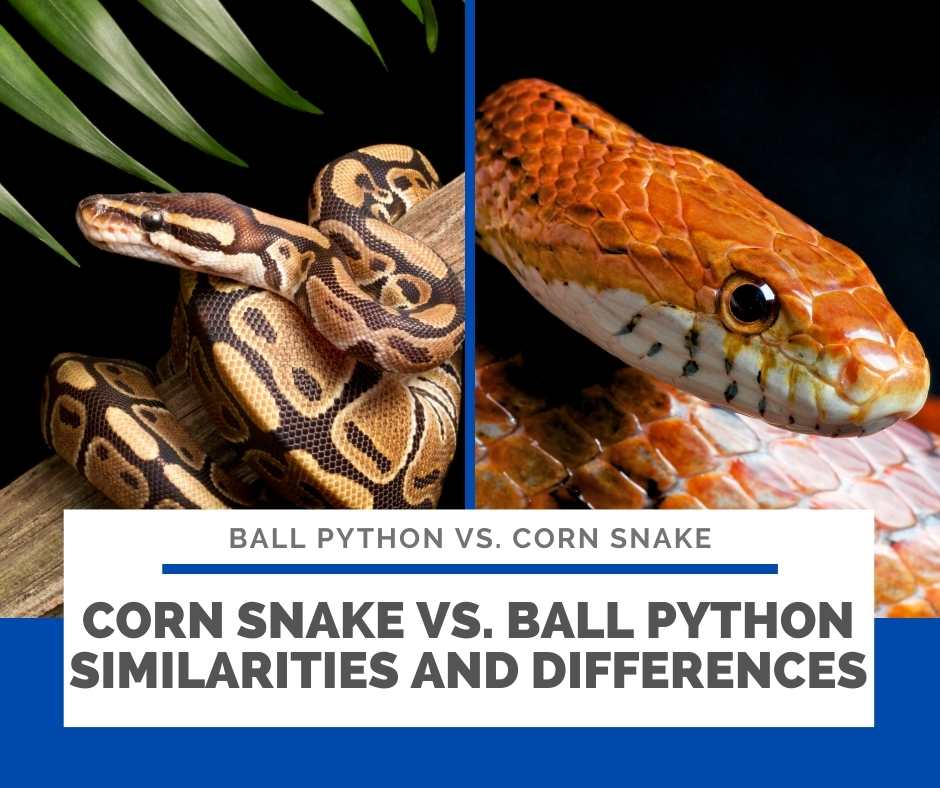
Ball pythons and corn snakes have plenty of similarities when it comes to habitation requirements. However, they still have some key differences. Let’s look at those similarities and differences.
Ball Pythons
Ball pythons scientifically known as Python Regius are desert natives from West Africa. They are therefore used to tropical climates and more humid areas.
Corn Snake
Corn snakes are scientifically known as Pantherophis guttatus. They are North American natives and belong to rat snake species. They are naturally spread in the East and Central parts of the US.
Length and Size
Size and length are the primary consideration for most beginner pet owners. I mean, who wants to keep a snake that is bound to grow to 15feet long?
Regarding this, ball python and corn snake do not get too long. However, ball pythons get thicker compared to a corn snake.
Both species only grow to a maximum length of about 3-5 feet. Thus, they both make great pets regarding length and size.
Pro Tip: Ask About Sex When Buying a Corn Snake or Ball Python
In most snake species, females tend to get bigger than the males. Thus, if a slight difference in length is a major issue for you, ensure that you enquire about the sex.
For instance, while male pythons grow to a maximum length of 3feet, females grow to an average length of 3-5feet.
Even so, the prices of female pythons are higher compared to their male counterparts. Thus, sex has significant influence when it comes to buying those serpents.
As for the thickness, ball pythons are thicker compared to corn snakes. Thus, the thickness makes a significant difference between corn snake and the ball python.
Habitat and Cage Climate
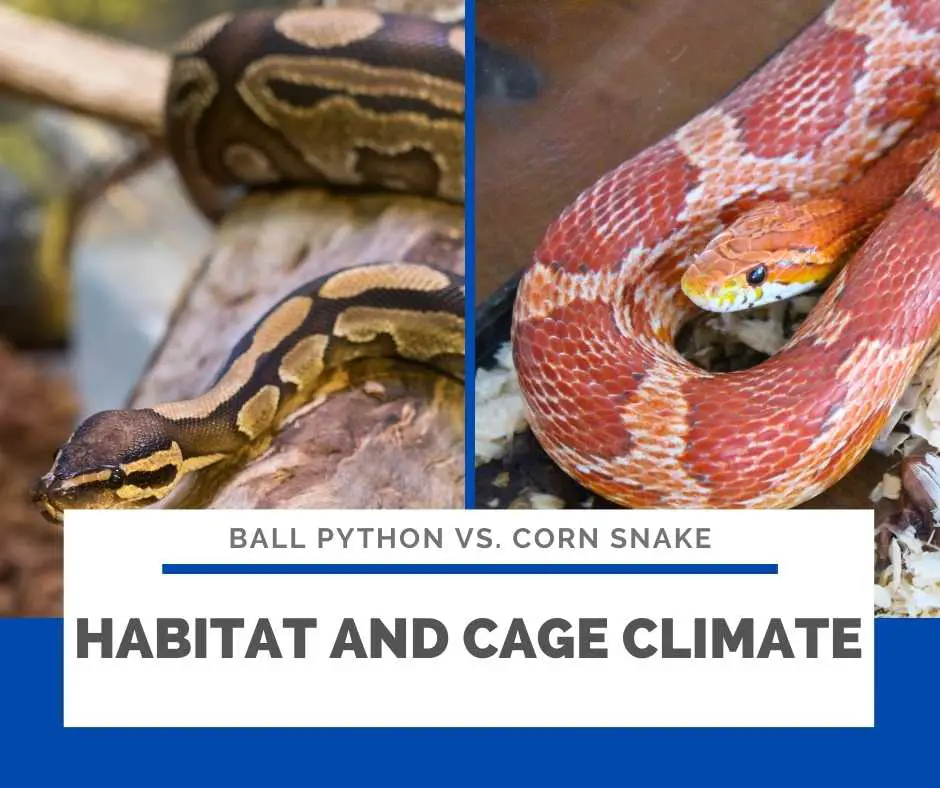
Ball pythons come from tropical areas where the climate is hot and only experience short rainy seasons. On the other hand, corn snakes are natives to North America, where the climate is more balanced.
West Africa and North American climates are different. Thus, these two species require significantly different cage set up.
However, concerning the cage, they both require approximately the same cage size. But, you might have to consider a few more aspects when setting up the cage.
These aspects include:
- Humidity
- Temperature
- Lighting
Ball Python and Corn Snake Humidity, Temperature, and Lighting
Ball pythons and corn snakes require almost the same cage setup except for the humidity. Here is a table showing the comparison of their cage setup requirements.
| Cage setup requirements | Ball Python | Corn Snake |
| Humidity | 50-60% | 30-50% |
| Ambient Temp | 76-830F | 75-820F |
| Basking Temp | 88-900F | 86-890F |
Corn Snake
Corn snakes are easier to maintain as they do not require lighting. However, it is necessary to provide a thermal gradient temperature in their enclosure.
You can use a heating mat on one side of the terrarium to provide thermal gradient temperatures. The warm side should be 86-890F and 75-820F on the cool side.
If you live in the United States, it might not be necessary to add humidifiers in the corn snake’s cage. It is because the average humidity in the US is 30%.
However, if you live in areas where the ambient moisture is below 30% or above 50%, you can consider using a reptile humidifier or a dehumidifier.
Ball Python
Ball python’s cage setup is slightly different from the corn snakes. However, just like the corn snake, lighting is not a necessity in their cage.
Even so, you must ensure that you provide a thermogradient temperature in their cage to make up for the basking and cold areas.
Underneath the tank, is better than the lighting bulbs since ball python prefers to warm their bodies from the belly.
The cold area should have temperatures ranging between 76-830F.
As for the humidity, ball pythons prefer areas with high humidity of 50-60%. If the ambient moisture is below 50%, you should regularly mist the ball python’s cage. Don’t forget to use a digital hygrometer to keep the moisture level intact.
Lifespan and Longevity
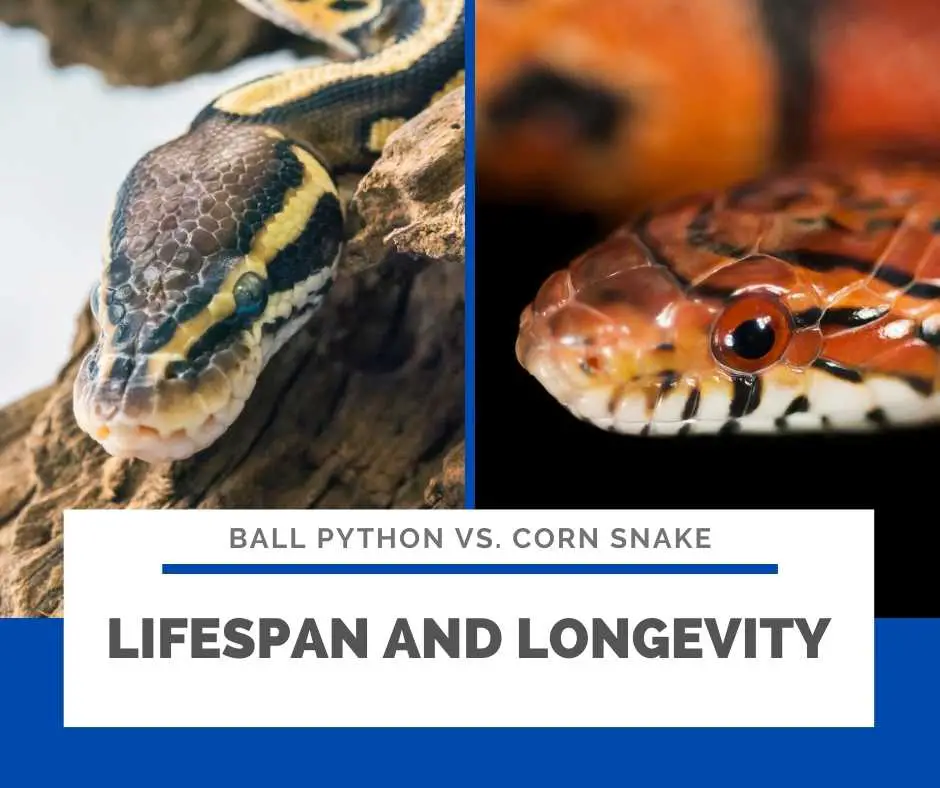
Ball pythons and corn snakes have different lifespans. For instance, ball pythons can live in captivity for 25-30years, while corn snakes only live for 20-25 years.
They both have a long life span, and thus, make good pets. However, ball pythons have a longer lifespan compared to corn snakes.
Therefore, if you prefer a snake pet with the most extended lifespan, ball pythons make better pets.
Even so, whichever pet you choose, remember that they both require a long term plan since they can both be around for more than 15 years.
Food Source and Diet
Rodents make the perfect meal for both ball python and a corn snake. Thus, whichever snake sounds ideal to you; the feeding cost remains the same for both.
However, you should ensure that the prey defrosted and no larger than 1.5 times their widest part when feeding a corn snake.
On the other hand, you can feed your ball python a prey that is as wide as its widest part.
Ball Python vs. Corn Snake Morphs and Color
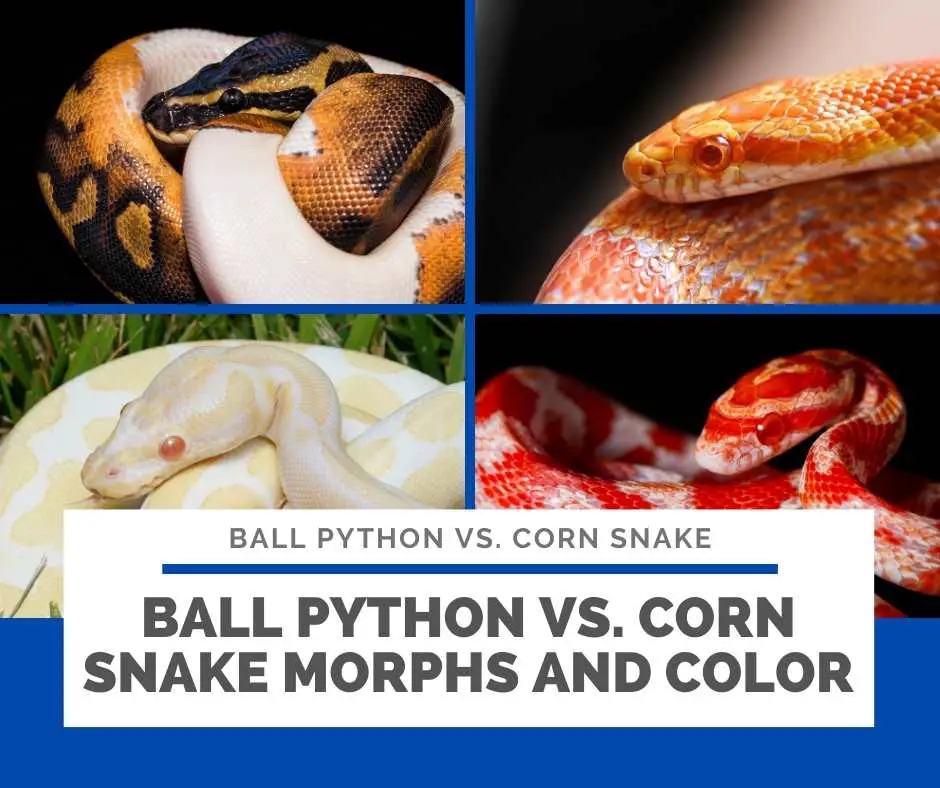
Corn snake and ball pythons are different when it comes to their physical looks.
Corn snakes are narrow-headed, and they also have a slender body. On the other hand, ball pythons are thick, and their heads are diamond-shaped.
Even so, ball pythons and corn snakes have different morphs. Morphs refer to snakes that belong to the same species but are selectively bred to create unique patterns and color variations.
Corn snakes come in different morphs, just like the ball pythons. However, they both have a basic morph that is usually cheaper.
Ball python basic morph comes in black or brown base colors. On the other hand, the basic corn snake is orange and brown.
Here is a list of some the morphs for each species
Corn Snake Morphs
- Lavender
- Black
- Albino
- Okeetee
Ball Python Morphs
- Banana
- Albino
- Bumblebee
- Chocolate
- Enchi
- Candino
- Butter
Cost of Ownership and Availability
The thought of owning a pet snake can be exciting. However, it comes with financial responsibilities, among others.
Some of these financial responsibilities include:
Cage Setup Cost:
Before bringing in your new pet, you must prepare its habitation. Snake enclosures come in different sizes and materials.
The cost of a cage setup includes:
- Enclosure $60-500
- Basking bulb $3-12
- Heating $25-70
- Substrate $5-30
- Décor (Vegetation, background, water bowl) $70
The Cost to Purchase Corn /Ball Python Snake
The next step after preparing the pet’s habitation is purchasing the snake. A basic ball python or corn snake can cost you $20-60 for a basic morph.
However, if you would love to own a designer morph, you must be ready to pay more than that. The cost of a standard morph depends on how rare it is. Thus, the most recent breeds are more expensive than common morphs.
Maintenance and Food Costs
Maintaining either a ball python or a corn snake is inexpensive. Since both snakes only feed once every 7-10 days, you can buy bulk frozen mice to reduce the cost per mouse.
However, you must be ready to spend a few more dollars a month for substrates, and cleaning detergents to keep the cage clean and free from mites.
Additionally, you must be ready to pay for veterinary services when the need occurs. However, the best way would be to take an insurance cover to cater to your pet’s health issues.
Health Issues
Most pet snakes suffer from common diseases. Most of these diseases affect both the corn and ball python snakes. These diseases include:
- Mouth rot
- Skin infections
- Respiratory diseases
- Septicemia
- Parasites
Mouth rot
It is a mouth infection that affects the ball pythons and corn snakes. Infected snakes tend to have bleeding gums or thick cheese cottage-like mucus around the mouth. The symptoms of mouth rot include:
- Lack of appetite
- Lethargy
- Swollen mouth
- Mouth breathing
Mouth rot can be caused by poor husbandry, poor nutrition, or a secondary infection after a mouth injury.
Skin Infections (Dermatitis)
Skin infection is mostly caused by poor habitation. It is a common problem in both ball python and a corn snake.
However, this disease can be avoided by regularly cleaning the snake’s cage and providing adequate humidity. Excessive or inadequate moisture is the major cause of skin infections in snakes.
Symptoms of skin infection include:
- Red inflammation on the skin
- Blister-like lesions
Respiratory Diseases
Respiratory diseases are also common to corn and ball python snakes. It is also caused by poor habitation, such as excessive humidity, inadequate temperatures, and bad substrates.
Symptoms of respiratory infections include:
- Nasal discharge
- Loss of appetite
- Lethargy
- Wheezing
- Mouth breathing
- Mucus in the mouth
Parasites
Both snakes can be affected by internal and external parasites. External parasites include mites and ticks.
Internal parasites include worms and coccidia. Though parasite infections might not show signs and symptoms, the pet’s vet should perform annual medical examinations.
Severe invasion of parasites may cause your snake pet to:
- Diarrhea
- Regurgitate
- Itching
- Skin irritation
- Difficulty in breathing
- Mouth infections
Inclusion Body Disease (IBD)
IBD is a viral disease that only affects pythons and boas. Thus, IBD is not common in corn snakes.
It is because corn snakes only have one functional lung, unlike ball pythons that have two lungs.
The disease affects either the digestive system or the respiratory tract. IBD is an infectious disease and is typically fatal.
Signs of IBD include:
- Paralysis
- Stargazing
Well, these are the most common health issues that affect ball pythons and corn snakes. From our study above, ball pythons have more health issues compared to corn snakes.
It is due to IBD disease that only affects pythons and not the corn snake. However, all other health issues are common in both snakes.
Handling
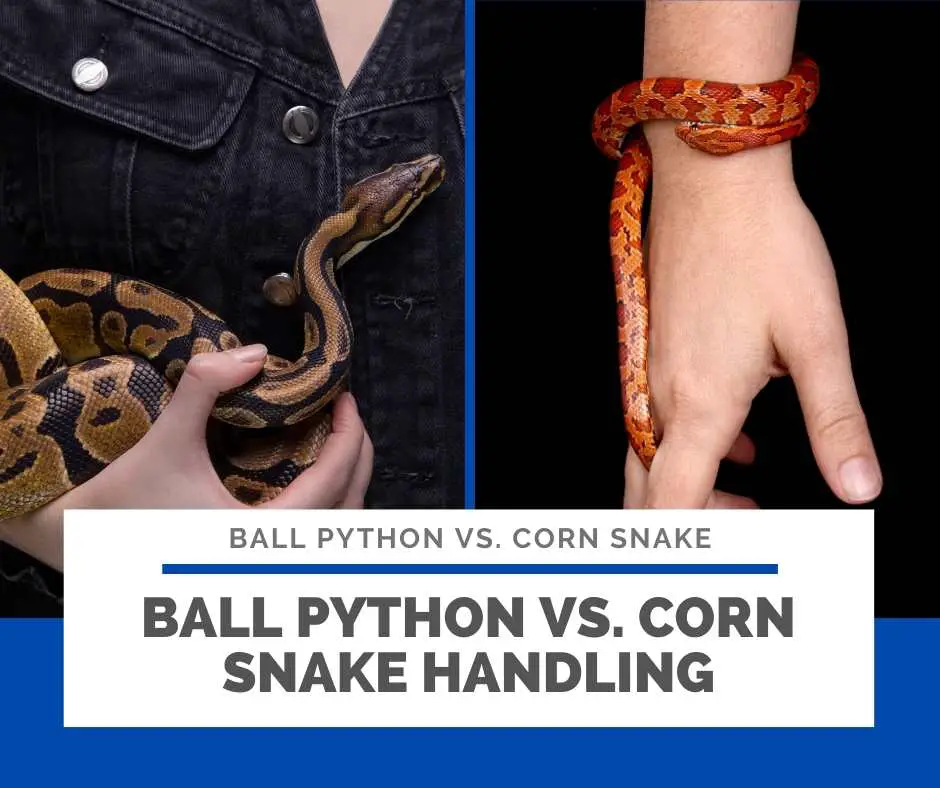
So, ball python vs. corn snake, which snake is easier to handle than the other? Well, the good news is that both two of those species are easy to handle.
They are also both non-venomous, and they do not require any special handling.
However, corn snakes are friendlier, social, and they rarely bite. Corn snakes rarely get defensive, and if they ever bite, their bite can barely break your skin.
On the other hand, ball pythons are shy and can get defensive. They also require more patience before handling them.
Since ball pythons spend most of their time curled or burrowed, even captivity they are not social. However, they barely bite, but unlike corn snake’s bite, which is never painful, ball python bite can be painful.
Therefore, corn snakes are better pets when it comes to handling compared to ball pythons.
Handling Best Practices
Whichever snake you choose between ball python and corn snake, it is critical to handle them regularly.
The best practice is when you handle them at least 2-3 times a week.
But, it is critical to understand your snake’s defensive behavior. Both corn and ball python get defensive when they feel threatened or stressed.
Symptoms of an aggregated snake may include:
- Coiling especially for ball pythons
- Hissing
- Tail wagging (corn snake)
Avoid handling your snake if it’s exerting all or some of these defensive characters. You should also never handle your snake before or after feeding.
Ball Python vs. Corn Snake- Which is Better for You?
Snakes are fun, hobby-driven pets to own. And, both ball pythons and corn snakes are competitive species for beginners.
There we go! You now know the difference between ball pythons and corn snakes. Which pet is best for you?
Corn snake might be your best pet if:
- You don’t like thick pythons.
- You like social snakes.
- You have no problem with snakes that don’t have varieties of colors and patterns.
- You have no problem with non-tropical snakes and non-pythons.
- You are okay with a pet that may only have to live for less than 20 years.
Ball python may e your best pet if:
- Color and pattern variations excite you more. Ball pythons have more color morphs compared to corn snakes.
- You have no problem with thick snakes.
- You have no problem with shy or reserved snakes.
- You are ready to stay with your pet for more than 20 years.
- You find tropical snakes more interesting.
Wrapping Up
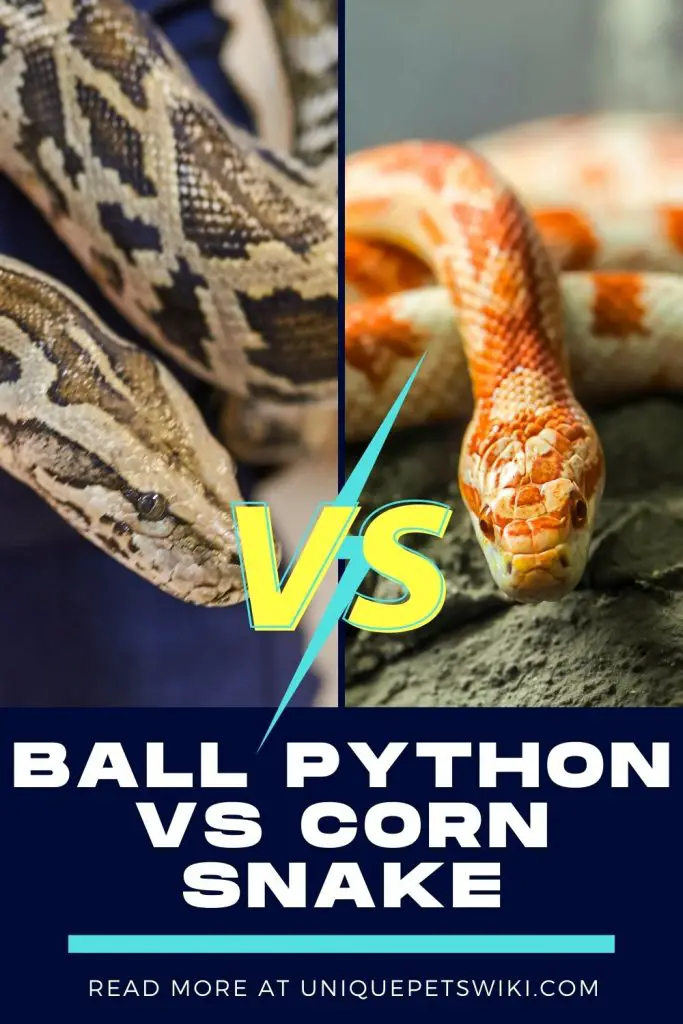
Corn snake and ball pythons are the most common species that are captive bred. They both make great pets due to their average size, long life span, easy to handle, and low maintenance cost.
Now that we have discussed everything you need to know about these pets, it is up to you to choose your best snake pet.
We wish you all the best with your ball python or corn snake.
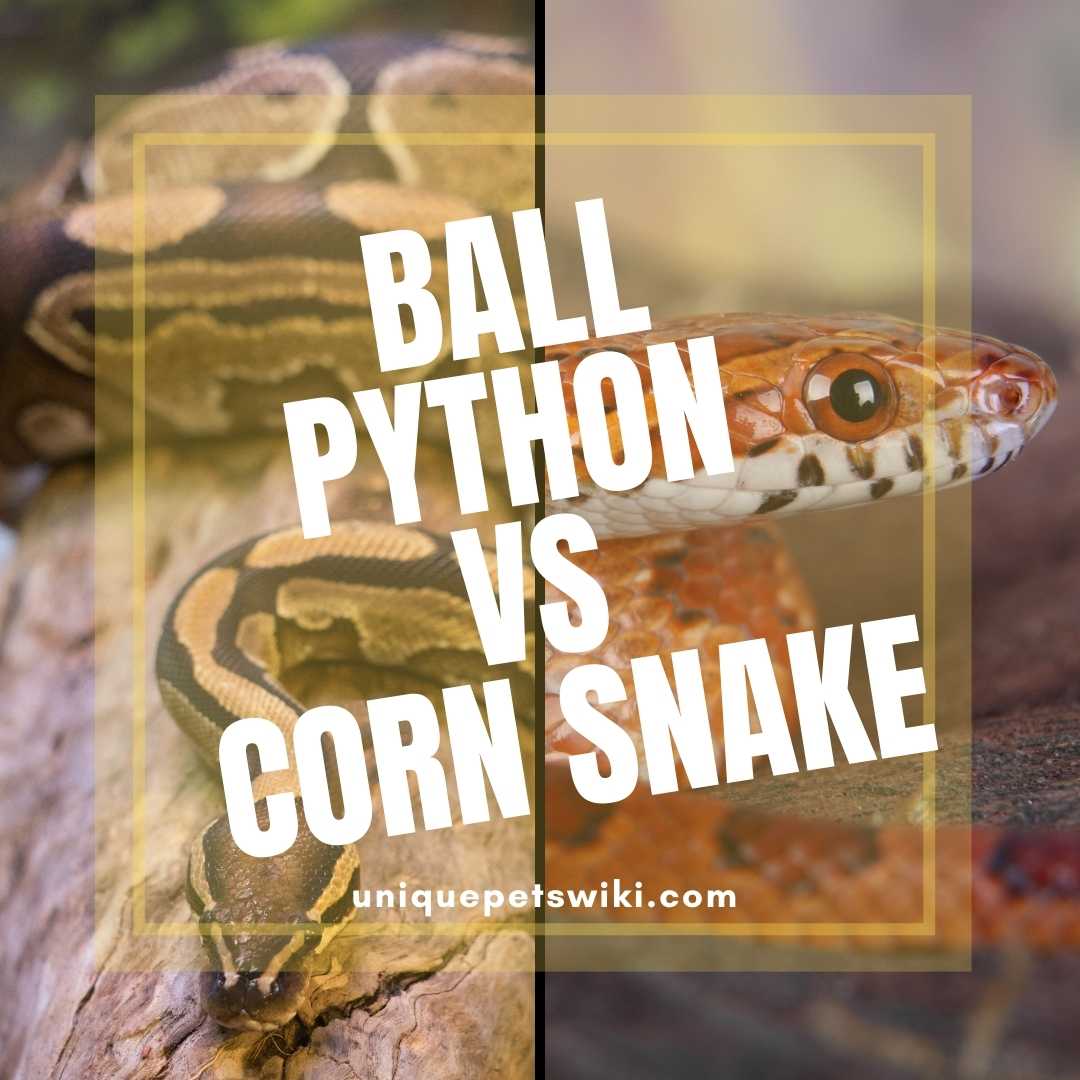
1 thought on “Ball Python vs Corn Snake- Which Pet Snake is the Best for You?”